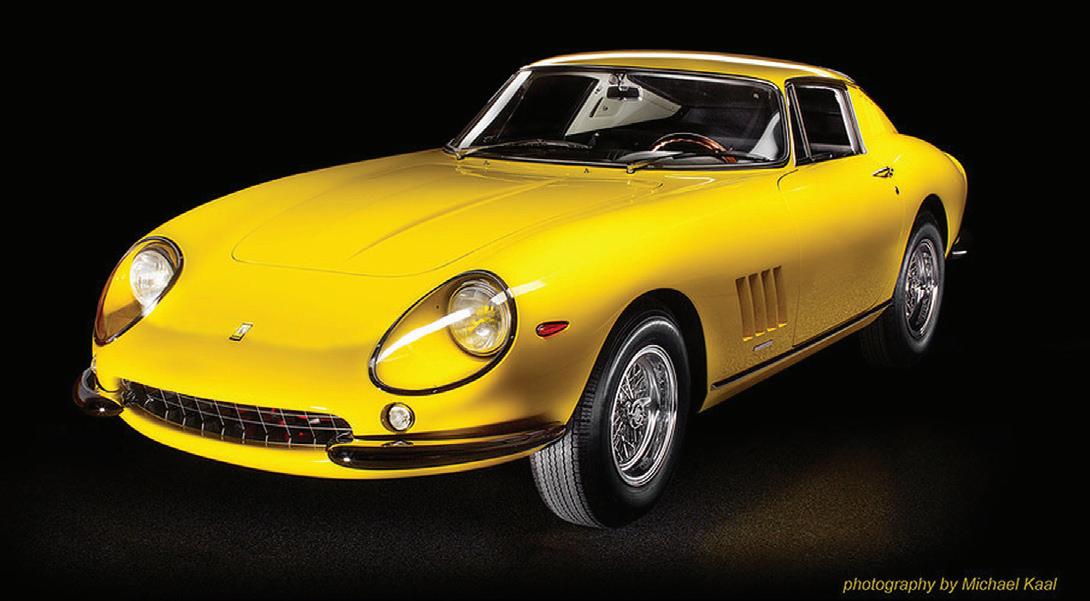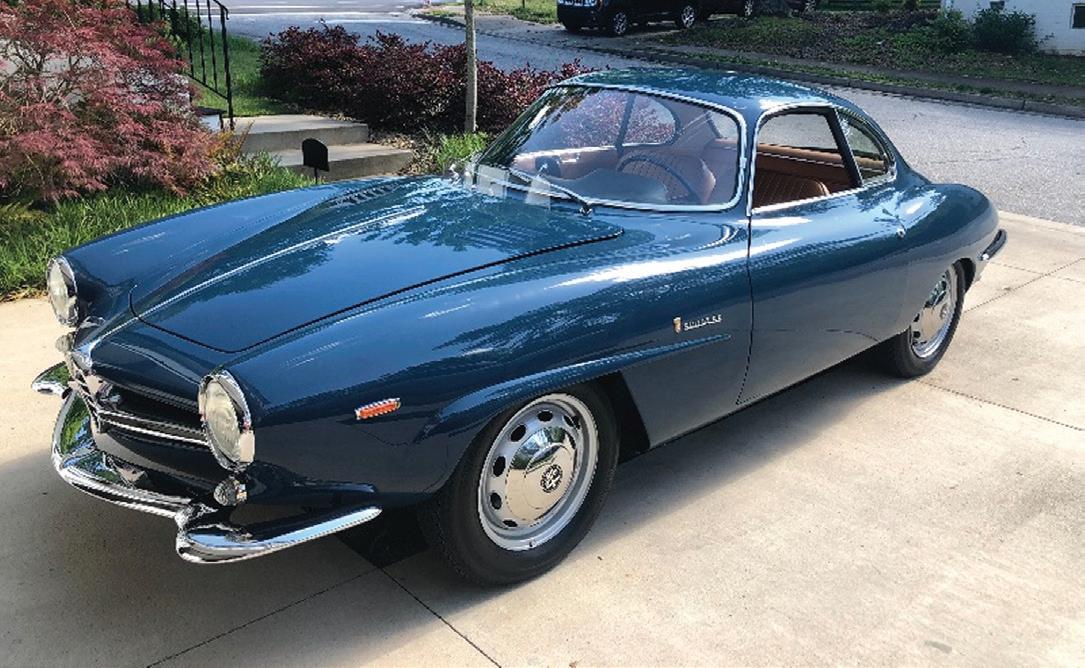
7 minute read
FreeWheeling: Classic Cars
FreeWheeling
Classic Cars in the Bascom
Mark Chmar of the Highlands Motoring Festival has worked diligently to curate exceptional examples of rare automobiles for the FreeWheeling exhibition. The following automobiles are a sampling of the cars that will be on display at The Bascom, and are representative of the caliber of vehicle viewers can expect to see inside the gallery. A special thank you goes to the lenders of these amazing automobiles whose willingness to share their private collections with the public is greatly appreciated.

Clark Gable's 1954 Jaguar XK 120 OTS
In 1948, William Lyons, Jaguar’s founder, created one of the most innovative and captivating cars of the era. The XK120 was so modern, it established Lyons as a legend in his own lifetime. The actual design took three months and a handbuilt prototype was completed in time for the 1948 Earls Court Motor Show. And at 120 mph, it was the sustained top speed of the new car. The XK 120 was competition ready, and was the fastest production car in the world achieving 132.6 mph when first introduced. With a 0 to 60 mph in 10 seconds, and a quarter mile in 17, the XK120 dominated immediate post-war racing. It handled superbly and had a successful racing history. Sixty percent of production ended up in the U.S. The engine design was so advanced, it was used until 1985. MGM Studios purchased this car for Clark Gable. They had the Los Angeles dealer install the Borrani wire wheels. The car was actually registered to the studio, as was customary, but maintained for Gable’s use exclusively. MGM subsequently sold the car to long-time set designer, who restored it in 1981.
A complete frame-off restoration has just been completed by Special Cars Only of Oldsmar, Florida. The Jaguar won Best Of Class Award at the 2006 Amelia Island Concours d’Elegance.

1965 Jaguar Series 1 E-type
Legend has it that when it went on display for the first time at the Geneva Motor Show in 1961, none other than Enzo Ferrari remarked that the E-type (known as the “XKE” in the U.S.) was the most beautiful car he’d ever seen. Mr. Ferrari knew a pretty car when he saw one and he might have been one of the first to express the sentiment, but an incalculable number of others have said virtually the same thing and they’re still saying it 60 years later. Designed by noted aerodynamicist Malcolm Sayer, the E-type was meant to cheat the wind, but its glass-covered headlights, long hood, short rear deck and compound curves also coincidentally looked great. With a 0-60 time of around seven seconds and a 150 mph top speed, the Series I E-type was near the top of the early 1960s food chain and was indeed quicker than numerous sports cars with a much higher price tag. A 2+2 coupe was added to the coupe and convertible body styles in 1966, and the 2+2 was the first E-type to be available with an automatic transmission. Parts are easy to find and not terribly expensive for any version of the E-type.
FreeWheeling
Classic Cars in the Bascom


1967 Ferrari 275 GTB/4 Alloy
Chassis Number 10269
Introduced at the 1964 Paris Motor Show, the 275 GTB replaced the 250 GT Berlinetta Lusso. The most important new mechanical features of the 275 GTB were the rearmounted gearbox and independent rear suspension. Ferrari already had plenty of experience of both systems in their competition cars, so the technology filtered through to the road models.
The 275 GTB was more aggressive in appearance than its predecessor. Fabled designer Pininfarina designed the body, and coachbuilder Scaglietti constructed it. These sleek-nosed, Kamm-tailed grand tourers from the midSixties were dubbed by Road & Track “the most satisfying sports car in the world” back then. This car is a 275 GTB/4. Introduced in 1966, the 275 GTB/4 was an updated version of the early 275 GTB. Power came from a substantially reworked 221 kW (300 PS) 3,285.72 cc Colombo V12, still with two valves per cylinder but now with four cams and six carburetors.
Most examples were built in steel with aluminum doors, hood, and trunk lid. However, a handful of examples – including this particular car – received full aluminum alloy bodies. Although Ferrari built 330 275 GTB/4 coupés in the 1966-1968 period, only 16 of these were bodied in aluminum panels. This example was fully restored in 2015. It wears its original colors, Giallo Fly (Fly Yellow) with black leather trim. The car is a multiple Platinum (Best in Class) award winner at shows sanctioned by the Ferrari Club of America.

1963 Corvette Split-Window Coupe
1963 was a defining year in Corvette history. It was the beginning of the 2nd generation design referred to as the C2. This generation spanned from 1963 through the 1967 model year, and represented several significant changes from the earlier C1 generation: The 1963 split window coupe is unique among not only the C2 generation, but among the entire Corvette lineup from its inception in 1953 to the latest mid-engine design that was introduced in 2020. The split rear window makes this model easily identifiable in that it was produced for only that single year. While that feature enhanced the body lines it also obstructed the driver’s rear view vision to the point that it was replaced by a single rear window glass in 1964. The design beauty of the 63 split window coupe along with its rarity makes this model possibly the most collectable of all vintage Corvettes. This Corvette on display here today has several attributes that makes it even rarer among the rare split window coupes. Most of the mechanical components are original including the fuel injected 327 cubic inch, 360 horsepower engine. Only about 6% of the 21,513 Corvettes manufactured in 1963 were fuelie coupes. The odometer reading of just over 71,600 is thought to be correct in that this vehicle has spent most of its life as a part of various vintage automobile collections.
A 3-year restoration that began in 2015, disassembled this car including removal of the body from the frame. Components that could not be restored were sourced from original old GM parts stock (New old stock) or rebuilt parts that matched the original equipment. Even the tires are period correct as noted by the absence of DOT numbers that became a manufacturing mandate by the US Department of Transportation in 1971.

FreeWheeling
Classic Cars in the Bascom

Shelby Cobra 427
The first 427 was produced in the Fall of 1964. There were 364 cars made in total between 1964 and 1967. The chassis and suspension were one of the first cars to be designed on a computer at Ford Motor Company. The hood, trunk and doors, are basically interchangeable between the 289 and 427, the headlights and taillight centers are the same, the front and rear fenders are larger to accept wider wheels and tires to handle the horsepower and torque of the larger engine. There are several different variants of the car, from full race competition cars to more basic street cars. There were 3 different variants on the wheels, and four different variants on the body. The first 154 cars had square taillights, and the remaining 210 had double round taillights. Competition cars came with larger wheel wells, roll bars, hood scoop, competition gas filler and larger 42-gallon fuel tank, and side pipes. Those were all accessories that could be added at the factory to street cars. Of the 364 427 cobras built, 100 were actually 428 engines instead of 427’s. It is the most popular replicated car on the planet.

1966 Porsche 906-158 Fuel injected
As the new head of Porsche Racing and development, Ferdinand Piech’s vision to create an entirely new generation of race cars resulted in the spectacular Carrera 6, known internally as the Type 906. Developed in a wind tunnel, the shape was both beautiful and curvaceous, while maintaining a drag coefficient of only 0.35. Among the very last of the 906’s built, this particular example is one of only 4 long nose, short tail, fuel injected models produced.

1965 Alfa Romeo Giulia Sprint Speciale
Alfa Romeo collaborated with Bertone to produce a series of Berlinetta Aerodinamica Technica studies that produced three concept cars: the B.A.T. 5, 7 and 9. Inspired by this partnership, the Bertone-designed Sprint Speciale appeared 1957. It was a very streamlined car and achieved a record (for a production car) .28 coefficient of drag, not bested for over 20 years. It was capable of 125mph with power coming from a potent 1.6-litre DOHC engine. There were only 1400 examples produced. This particular matching numbers car received a comprehensive restoration around 12 years ago and is finished in its original color of Blu Medio.



